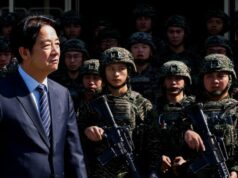South Korean lawmakers have revealed that North Korea has positioned an intercontinental ballistic missile (ICBM) launcher, potentially preparing for a test around the US presidential election on November 5. Citing military intelligence, officials suggest that North Korea may time the launch to showcase its advanced weapons capabilities during a high-stakes period on the international stage.
Potential Election-Related Timing for Missile Test
South Korean MP Lee Seong-kweun informed reporters on Wednesday that a mobile launcher has been deployed to a specific site, with preparations complete for a potential ICBM test. Lee stated that the missile launch would aim to verify the missile warhead’s atmospheric re-entry, marking a significant technical milestone. “An ICBM launch for technological verification of warhead re-entry could take place, with a timing targeting the U.S. presidential election, either before or after, in November,” Lee explained.
The Defence Intelligence Agency (DIA) disclosed this information in a closed-door parliamentary session, adding weight to the assessment that North Korea may opt to demonstrate its long-range missile capabilities to maximise international attention.
Deployment and Readiness of North Korea’s Missile Launcher
The DIA has confirmed that North Korea’s transporter-erector launcher (TEL) is fully deployed and prepared for an ICBM launch. However, according to South Korean MP Park Sun-won, the missile itself may not yet be loaded onto the launcher, although it could already be on-site. The missile’s transport to the launch location underscores North Korea’s intent to enhance its ICBM capabilities, specifically by addressing technical challenges related to re-entry, which are essential for missile accuracy and reliability.
In recent tests, North Korea has launched missiles at steep angles, limiting their range while allowing them to land closer to North Korean territory. This method is a tactical choice, aiming to avoid the geopolitical consequences of firing missiles into the wider Pacific. However, military analysts note that a test on a standard, flatter trajectory would be crucial for North Korea to validate the missile’s capability to re-enter the atmosphere and hit a distant target.
Given that North Korea has not conducted a nuclear test since its sixth test in 2017, a seventh test or an ICBM launch around the US election could serve as a stark signal of North Korea’s advancing capabilities and a message about its self-perceived position in global strategic dynamics.
(with inputs from reuters)
Research Associate at StratNewsGlobal, A keen observer of #China and Foreign Affairs. Writer, Weibo Trends, Analyst.
Twitter: @resham_sng




